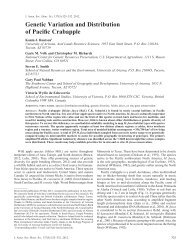CONSERVATION
Conservation You Can Taste - The Southwest Center - University of ...
Conservation You Can Taste - The Southwest Center - University of ...
- No tags were found...
Create successful ePaper yourself
Turn your PDF publications into a flip-book with our unique Google optimized e-Paper software.
“One reason we are still making a table wine from our acre of Mission<br />
grapes is that it was the first European variety brought to the New<br />
World and was originally planted not too far from us in southern New<br />
Mexico in 1629. It has been passed down and planted as an heirloom<br />
variety in our region for over three hundred and eighty years. So<br />
we are doing it as much for posterity and for the future as we are<br />
for profit. It’s our modest contribution to maintaining traditions.”<br />
Chris Wickham, Vitner, Tularosa Vineyards, Tularosa NM<br />
States. Many apples and pears that fell out of fashion during Prohibition for lack of ship-ability<br />
or fresh eating quality are now being rediscovered by cider makers and brandy distillers. If it<br />
were not for the interest of apple brandy makers at Germain-Robin artisanal distillers near<br />
Ukiah, California, the Sierra Beauty apple would have little value-added market distinction.<br />
The artisanal cider makers and distillers emerging all across North America will often pay twice<br />
the value per ton of fruit that orchard-keepers can garner from groceries or at roadside stands.<br />
As such, artisanal processing of ciders and spirits—like heirloom-focused farmers markets and<br />
festivals—are literally keeping dozens of fruit varieties alive that might otherwise go extinct.<br />
Of the fourteen fruits, nuts and berries now boarded onto the Ark of Taste that we selected<br />
for study, the average number of nurseries carrying them is 2.6, and an average of 11.5 growers<br />
are now making part of their livelihoods by direct-marketing these fruits or their valueadded<br />
products to the public. The Meyer lemon is being offered through the largest number<br />
of nurseries (17), and it also has the most growers who list on localharvest.org (73), while<br />
most other heirloom rarities still have less than ten growers nationwide. The Mission olive of<br />
California and Arizona is next in importance, with 17 growers, most of whom cold-press its<br />
extra virgin olive oil. Because of the longer time to maturation and harvest for tree crops than for<br />
field vegetables, it is not surprising that the pace of recovery for fruits, nuts and berries lags far<br />
behind that for annual field crops. They are also more vulnerable to climate change, since many<br />
of them are typically long-lived so can suffer dramatic changes in climate over their life time.<br />
42



